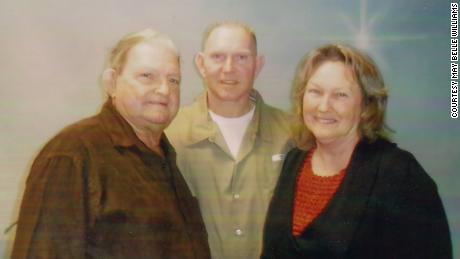Russ soon got another call: James, a 65-year-old inmate with diabetes and HIV, had tested positive for the virus himself. Within days, he was rushed to a hospital as his oxygen levels plummeted. A few weeks later, after his condition deteriorated and he was placed on a ventilator, he was dead. As coronavirus has spread rapidly through prisons and jails around the country in recent months, the Texas lockup where Giannetta spent his last days has emerged as the hardest-hit federal prison in the United States. More than 1,300 of the roughly 1,750 prisoners at FCI Seagoville prison and camp have tested positive for the virus, according to data from the federal Bureau of Prisons — a stunning three out of every four inmates. So far, three inmates at the prison, including Giannetta, have died from Covid-19. Five Seagoville inmates told CNN in phone interviews from behind bars that they feared for their lives as the virus rushed through the Dallas-area prison, and that the crowded conditions made it all but impossible for them to stay socially distanced. "It came through here so fast that it's out of control," said Bobby Williams, an immunocompromised inmate who has about three years left on a more than two-decade drug sentence. He said he came down with severe pneumonia after contracting Covid-19 in June. "We're packed like sardines." As the BOP has scrambled to stanch the spread of the virus in its facilities, the toll at Seagoville and elsewhere raises questions about whether the Trump administration is doing enough to release elderly and medically vulnerable prisoners — even as several high-profile inmates like former Trump campaign manager Paul Manafort, former Trump lawyer Michael Cohen and the rapper Tekashi 6ix9ine have been released from prison to home confinement. The BOP declined repeated requests for an interview with officials at Seagoville or national officials involved in setting coronavirus policy. A spokesperson said the agency distributed cloth masks to every inmate and guard, began mass testing of inmates in the prison by late June and stepped up sanitation procedures, among other policy changes. But the low-security men's prison — which once held Japanese and German detainees during World War II, among others — is now a cautionary tale for how quickly the coronavirus can take deadly hold in correctional facilities. Since the beginning of May, when there was only a single coronavirus case at Seagoville, the number of inmates who have tested positive has soared to 1,333, according to BOP data (including prisoners at a minimum-security camp next to the prison). Twenty-eight of the roughly 300 prison employees have also tested positive. The outbreak means that the facility has more coronavirus cases than about 85% of the counties in the US. Dr. Homer Venters, the former chief medical officer for New York City's jail system, who has inspected federal prisons' coronavirus response plans, said outbreaks at Seagoville and other prisons were like "popcorn kernels popping off over an extended period of time.""There are many facilities that either have gone through the same thing or will," he predicted. "This is really a tragic situation that's playing out all over the country."
Early release programs fall short
Prisoner rights advocates say that the BOP has fallen short on the most effective way to save inmate lives: reducing the number of vulnerable people inside the prisons. Federal inmates have two paths to early release during the pandemic. The BOP is evaluating inmates for home confinement, which is granted based on factors like inmates' age, risk factors for Covid-19, the seriousness of their offense and their conduct in prison. Manafort and several other high-profile inmates were released under this method, which was expanded under the CARES Act earlier this year.The agency has released 7,444 inmates to home confinement nationwide over the last four-and-a-half months, according to data released by the agency, out of the more than 157,000 total in the federal system. A spokesperson declined to provide specific numbers for Seagoville or other individual prisons, citing "the fluid nature of the pandemic situation." Inmates can also apply for compassionate release, a procedure that was streamlined with the passage of the First Step criminal justice reform act in 2018. Inmates with health issues can ask a judge to reduce their sentence; they can also apply to their warden for the federal government to file a court motion for release on their behalf. So far, roughly 900 additional inmates have been released through that track this year, according to Families Against Mandatory Minimums, a criminal justice reform group that has helped recruit attorneys to represent inmates in coronavirus cases. 
 But criminal justice experts call the releases so far a drop in the bucket compared with the vast numbers of elderly and medically vulnerable people in federal custody. Kevin Ring, the president of FAMM, said federal officials had been arguing in court against many inmates who have petitioned for compassionate release. "It's been disappointing because most of these people were elderly and sick and now they're the most at risk from this disease," Ring said, arguing that the Trump administration "should have been clearing these people out." Instead, he said, officials were "slow to react" when the coronavirus started its deadly march through prisons around the country. "We've watched it hop from facility to facility — when it hits one, it ravages it," Ring said. "It has been terrifying to watch."Nationally, more than 10,000 federal inmates and 1,300 BOP employees have tested positive for coronavirus, while 111 inmates and one staffer have died. Several other federal prisons have also faced dramatic outbreaks, although none that infected as many inmates as Seagoville's. In Ohio, a judge ordered officials to release or transfer more than 800 vulnerable inmates at another federal prison ravaged by the virus, saying the conditions in the facility had possibly reached the level of "cruel and unusual punishment." But an appeals court struck down that order in June, finding that the inmates did not prove the BOP was "deliberately indifferent" to the risks presented by Covid-19.Some Democrats in Congress have pointed to Manafort's release to argue that the administration isn't treating inmates equally. If the coronavirus was "deadly enough of a virus that you needed to protect the former campaign manager, why not all of these Americans who also are vulnerable and have at-risk conditions?" Rep. Sylvia Garcia, D-Texas, asked Attorney General William Barr at a House hearing last week. Barr said he had nothing to do with the decision to send Manafort home but noted that the department had released thousands of inmates.
But criminal justice experts call the releases so far a drop in the bucket compared with the vast numbers of elderly and medically vulnerable people in federal custody. Kevin Ring, the president of FAMM, said federal officials had been arguing in court against many inmates who have petitioned for compassionate release. "It's been disappointing because most of these people were elderly and sick and now they're the most at risk from this disease," Ring said, arguing that the Trump administration "should have been clearing these people out." Instead, he said, officials were "slow to react" when the coronavirus started its deadly march through prisons around the country. "We've watched it hop from facility to facility — when it hits one, it ravages it," Ring said. "It has been terrifying to watch."Nationally, more than 10,000 federal inmates and 1,300 BOP employees have tested positive for coronavirus, while 111 inmates and one staffer have died. Several other federal prisons have also faced dramatic outbreaks, although none that infected as many inmates as Seagoville's. In Ohio, a judge ordered officials to release or transfer more than 800 vulnerable inmates at another federal prison ravaged by the virus, saying the conditions in the facility had possibly reached the level of "cruel and unusual punishment." But an appeals court struck down that order in June, finding that the inmates did not prove the BOP was "deliberately indifferent" to the risks presented by Covid-19.Some Democrats in Congress have pointed to Manafort's release to argue that the administration isn't treating inmates equally. If the coronavirus was "deadly enough of a virus that you needed to protect the former campaign manager, why not all of these Americans who also are vulnerable and have at-risk conditions?" Rep. Sylvia Garcia, D-Texas, asked Attorney General William Barr at a House hearing last week. Barr said he had nothing to do with the decision to send Manafort home but noted that the department had released thousands of inmates. All five of the Seagoville inmates interviewed said they had been denied compassionate release or home confinement, and some said their families were planning to go to court. In a message denying his request for compassionate release, the prison's warden wrote that "at this time COVID-19 is not considered extraordinary compelling circumstances" under the BOP's compassionate release policy, inmate George Reagan told CNN.The BOP spokesperson said the agency didn't comment on specific inmates' requests for early release. For some inmates, the potential of early release came too late. Giannetta, a Massachusetts native who was serving a 14-year sentence for selling methamphetamine and other charges, applied for an early release from the warden and was denied, according to a filing by his court-appointed lawyer. The lawyer submitted an expedited motion for compassionate release on July 3, after he had already tested positive and been sent to a hospital. A judge dismissed the petition as moot after Giannetta died at the hospital on July 16. Giannetta's older brother Russ, a physics professor at the University of Illinois, said in an interview that he had sent medical documents outlining his brother's myriad health issues to officials at the prison and even wrote a letter to the Centers for Disease Control and Prevention, but his pleas for help didn't seem to have any effect.The Seagoville facility was a "petri dish," Russ said. He said James knew even before he tested positive that he was in real danger: "He had a pretty good premonition that this was not a place that was going to be able to contain this virus if it broke out."
All five of the Seagoville inmates interviewed said they had been denied compassionate release or home confinement, and some said their families were planning to go to court. In a message denying his request for compassionate release, the prison's warden wrote that "at this time COVID-19 is not considered extraordinary compelling circumstances" under the BOP's compassionate release policy, inmate George Reagan told CNN.The BOP spokesperson said the agency didn't comment on specific inmates' requests for early release. For some inmates, the potential of early release came too late. Giannetta, a Massachusetts native who was serving a 14-year sentence for selling methamphetamine and other charges, applied for an early release from the warden and was denied, according to a filing by his court-appointed lawyer. The lawyer submitted an expedited motion for compassionate release on July 3, after he had already tested positive and been sent to a hospital. A judge dismissed the petition as moot after Giannetta died at the hospital on July 16. Giannetta's older brother Russ, a physics professor at the University of Illinois, said in an interview that he had sent medical documents outlining his brother's myriad health issues to officials at the prison and even wrote a letter to the Centers for Disease Control and Prevention, but his pleas for help didn't seem to have any effect.The Seagoville facility was a "petri dish," Russ said. He said James knew even before he tested positive that he was in real danger: "He had a pretty good premonition that this was not a place that was going to be able to contain this virus if it broke out."
Prison struggles to respond to outbreak
In interviews, inmates at Seagoville described a chaotic response to the outbreak by prison officials, whose efforts to slow the spread of the virus were hampered by delayed test results and a lack of enforcement of mask-wearing policies. Bobby Williams, who has skin cancer and takes medicine that reduces his immune response, said he came down with pneumonia after testing positive for the virus. "I thought I was going to die," he said. "I was passing out, I couldn't breathe."He said doctors at the prison gave him steroid shots and a nasal spray that helped, but over a month later, he still feels the impact from the virus. Williams, 56, has been in federal prison for 22 years and has about three-and-a-half years left to go on drug and money laundering convictions. Venters, the former New York jail medical officer, has conducted dozens of inspections of coronavirus response efforts in prisons and jails around the country, including BOP facilities. He said that while he hadn't inspected Seagoville, the numbers and stories shared by inmates were troubling.  "What I've found over and over is there is no special protections or special surveillance for high-risk patients," Venters said. In many BOP facilities, he said, "I have observed very large numbers of people in very close quarters, which makes the spread of this virus inevitable once somebody becomes sick."One difficulty has been the delay in getting test results. Curtis Severns, a Seagoville inmate scheduled to be released next year after an arson conviction based on disputed evidence, said that he and other inmates faced a four-day delay between taking a test and getting the result last month — which meant that the prison didn't move some positive inmates out of the general population until it was too late.The BOP spokesperson said Seagoville was using a rapid 15-minute test machine as well as commercial lab tests that have turnaround times of three to 10 days.Severns, who tested positive and was mostly asymptomatic, said he is now living with five roommates — all of whom have also tested positive — in a small former TV room converted to housing. "I was amazed just how fast (the virus) went, once it started going," he said. "I think everybody here's going to get it."Mask wearing has been spotRead More – Source
"What I've found over and over is there is no special protections or special surveillance for high-risk patients," Venters said. In many BOP facilities, he said, "I have observed very large numbers of people in very close quarters, which makes the spread of this virus inevitable once somebody becomes sick."One difficulty has been the delay in getting test results. Curtis Severns, a Seagoville inmate scheduled to be released next year after an arson conviction based on disputed evidence, said that he and other inmates faced a four-day delay between taking a test and getting the result last month — which meant that the prison didn't move some positive inmates out of the general population until it was too late.The BOP spokesperson said Seagoville was using a rapid 15-minute test machine as well as commercial lab tests that have turnaround times of three to 10 days.Severns, who tested positive and was mostly asymptomatic, said he is now living with five roommates — all of whom have also tested positive — in a small former TV room converted to housing. "I was amazed just how fast (the virus) went, once it started going," he said. "I think everybody here's going to get it."Mask wearing has been spotRead More – Source
[contf] [contfnew] 
cnn
[contfnewc] [contfnewc]






